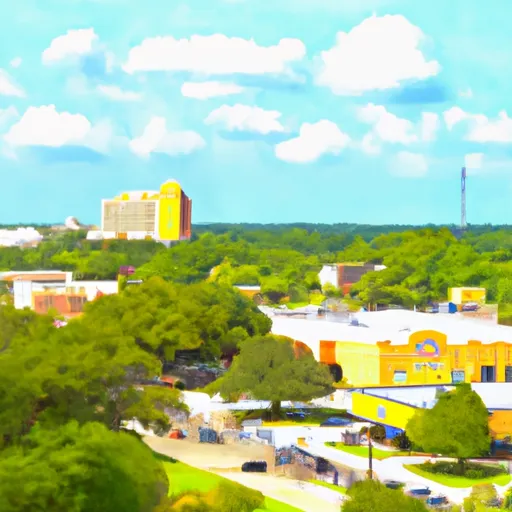-
 Snoflo Premium
Snoflo Premium
Get unlimited access to all our content
With no Ad interruptions! - Start Your Free Trial Login with existing account
Ocala
Eden Index
Climate
7.3
•
Recreation
5.1
•
Community
2.2
•
Safeguard
5.2/10

Ocala, Florida is located in Marion County and has a humid subtropical climate. Summers are hot and humid, with temperatures averaging in the low 90s°F (32°C), while winters are mild with temperatures in the low 70s°F (21°C). The region experiences abundant rainfall throughout the year, with the wettest months being June through September.
Ocala is blessed with numerous lakes, rivers, and springs that make up its hydrology constituents. The area is home to the famous Silver Springs State Park, known for its crystal-clear spring and glass-bottom boat tours. Outdoor enthusiasts can also explore the Ocala National Forest, which offers opportunities for hiking, camping, boating, and fishing. Additionally, the region boasts excellent horseback riding trails, making it a popular destination for equestrians. Ocala's diverse outdoor recreation opportunities make it a haven for nature lovers.
What is the Eden Index?
The Snoflo Eden Index serves as a comprehensive rating system for regions, evaluating their desirability through a holistic assessment of climate health, outdoor recreation opportunities, and natural disaster risk, acknowledging the profound impact of these factors on livability and well-being.
Climate Health Indicator (CHI): 7.3
Ocala receives approximately
1273mm of rain per year,
with humidity levels near 89%
and air temperatures averaging around
22°C.
Ocala has a plant hardyness factor of
9, meaning
plants and agriculture in this region tend to thrive here all year round.
By considering the ideal temperature range, reliable water supplies, clean air, and stable seasonal rain or snowpacks, the Climate Health Indicator (CHI) underscores the significance of a healthy climate as the foundation for quality living.
A healthy climate is paramount for ensuring a high quality of life and livability in a region, fostering both physical well-being and environmental harmony. This can be characterized by ideal temperatures, reliable access to water supplies, clean air, and consistent seasonal rain or snowpacks.
Weather Forecast
Streamflow Conditions
St. Johns
Area Rivers
St. Johns
Snowpack Depths
St. Johns
Reservoir Storage Capacity
St. Johns
Groundwater Levels
Recreational Opportunity Index (ROI): 5.1
The Recreational Opportunity Index (ROI) recognizes the value of outdoor recreational options, such as parks, hiking trails, camping sites, and fishing spots, while acknowledging that climate plays a pivotal role in ensuring the comfort and consistency of these experiences.
Access to outdoor recreational opportunities, encompassing activities such as parks, hiking, camping, and fishing, is crucial for overall well-being, and the climate plays a pivotal role in enabling and enhancing these experiences, ensuring that individuals can engage in nature-based activities comfortably and consistently.
Camping Areas
| Campground | Campsites | Reservations | Toilets | Showers | Elevation |
|---|---|---|---|---|---|
| Silver Lake - Withlacoochee State Forest | 23 | 78 ft | |||
| Hog Island - Withlacoochee State Forest | 20 | 72 ft | |||
| Lithia Springs | None | 51 ft | |||
| River Jct - Withlacoochee State Forest | 20 | 67 ft | |||
| Hillsborough River State Park | None | 58 ft | |||
| Alafia River State Park | None | 117 ft | |||
| Withlacoochee River Park | 10 | 94 ft | |||
| Edward Medard | None | 79 ft | |||
| Cypress Glen - Withlacoochee State Forest | 34 | 72 ft | |||
| Crooked River - Withlacoochee State Forest | 26 | 72 ft |
Catastrophe Safeguard Index (CSI):
The Catastrophe Safeguard Index (CSI) recognizes that natural disaster risk, encompassing floods, fires, hurricanes, and tornadoes, can drastically affect safety and the overall appeal of an area.
The level of natural disaster risk in a region significantly affects safety and the overall livability, with climate change amplifying these risks by potentially increasing the frequency and intensity of events like floods, fires, hurricanes, and tornadoes, thereby posing substantial challenges to community resilience and well-being.
Community Resilience Indicator (CRI): 2.2
The Community Resilience Indicator (CRI) recognizes that education, healthcare, and socioeconomics are crucial to the well-being of a region. The CRI acknowledges the profound impact of these elements on residents' overall quality of life. By evaluating educational resources, healthcare accessibility, and economic inclusivity, the index captures the essential aspects that contribute to a thriving community, fostering resident satisfaction, equity, and social cohesion.

